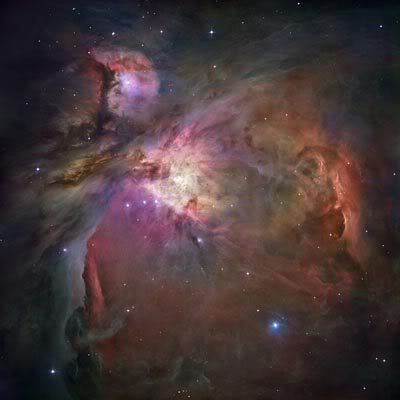
The yellow giant
alpha Aur, called
Capella, is the 6th brightest star in the sky (0.08 mag). It is also a spectroscopic binary consisting of a G5III and a G0III. They revolve each other every 104 days.
Menkalinen,
beta Aur, is also a spectroscopic binary. Within just four days the stars complete their revolution much faster than those of
alpha Aur. Since they are eclipsing each other the brightness of
beta Aur seems to vary.
The eclipsing binary
epsilon Aur has an extraordinary long period; every 27.1 years the brightness varies from 3.0 mag down to 3.8 mag as the brighter component is then eclipsed by the darker companion. This eclipse lasts a full year (the last eclipse took place in 1983). Calulations show that the dark component of
epsilon Aur has about 10 -12 solar masses. Because of its small size it is a good candidate for a black hole; unfortunately this conflicts with the observed lost of brightness during the eclipse. According to studies of
Wilson and
Cameron the solution is a ring of obscuring material which surrounds the black hole. (There is still doubt that the companion is a black hole; a star which a 10 times smaller brightness would fit the model, too.)
Another eclipsing binary is
zeta Aur; a K4 bright giant and a B8 main sequence star revolve each other every 2 2/3 years.
The double
omega Aur can be viewed with small telescopes; it consists of a 5th mag and a 8th mag companion.
Telescopes with an aperture of at least 100mm and a high magnification are required to split the tight double
theta Aur. An A0psi star of 2.62 mag is accompanied by a star of 7th mag.
The planetary nebula
NGC(*) 2149 (the asterisk indicates that this object can be found in the NGC supplementary catalogs of J.L.E. Dreyer) appears as a small oval ring of 10th mag.
The diffuse nebula
I 405 is also called
Flaming Star.
I 410 consists of a cluster with an nebulosity attached.
There a several open clusters in this constellations.
About 60 members belong to
M36. Its a good object for the use of binoculars. A beautiful group of stars is
M38 showing an oval shape. The richest of these three Messier objects is
M37. It contains about 150 stars with magnitudes of 12.5 and brighter and about 500 in total. Detailed information about all three Messier objects can be found in the Messier database.
The meteor shower of the
Aurigids is generally observable between January, 31st, and February, 23rd. This shower is known for its bright fireballs.
From August, 25th, till September 6th, the shower of the
Alpha Aurigids is active. Although the annual maximum is about 9 meteors, outbursts of up to 30 were observed in 1935 and 1986.
Source:
Seds












